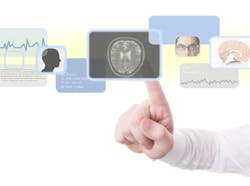It was nearly 20 years ago when a clinician (non-psychiatrist) brought up the notion of telepsychiatry to James Varrell, M.D., a licensed psychiatrist himself who at the time didn’t know much about the telemedicine subsector. “This was 1999 and it was like voodoo to me,” Varrell says, adding that after that conversation he needed to do his due diligence and research.
What came from that conversation, and ensuing exploration into telepsychiatry, was a realization that there was more support for it than Varrell initially assumed. In fact, the American Psychiatric Association (APA) put out a significant paper in 1995 in support of telepsychiatry, and it was around that time when research began on its ability to facilitate access to care, overcome geographical obstacles and how it compared to in-person care. “All of the go-to organizations in the [industry] have always been supportive of it. Clinicians individually have been skeptical since they’ve never done it. But now, many [places] are incorporating into their residency programs,” Varrell says.
Indeed, folks might not be as familiar with telepsychiatry as they are with other forms of telemedicine, since behavioral health often flies under the radar compared to its physical health brethren. But according to the APA, by the 2000s, the field began to see it as effective, but slightly different, than in-person care, and research in outcome studies provided a platform for practice guidelines, via the American Telemedicine Association.
Varrell says that today’s mental health landscape is characterized by an increased need for services coupled with a dwindling supply of psychiatrists. Indeed, more than 55 percent of U.S. counties are currently without any psychiatrists, and the mental health landscape is facing shortages in more than 4,600 areas, according to Kaiser. Varrell, who has been practicing telepsychiatry for 18 years ever since it was brought up to him back in 1999, now works at telepsychiatry service provider organization InSight, a Marlton, N.J.-based company that he founded in 2008 and where he currently oversees a team of more than 200 psychiatrists and psychiatric nurse practitioners—many of whom work full-time doing telepsychiatry.
James Varrell, M.D.
Speaking to the growth in the sector, Varrell says that his company began with telepsychiatry mostly in ERs where patients in crisis environments were prioritized. But, he notes, “The place more than anywhere where it started to develop was in rural environments, where access to basic psychiatry care would be otherwise inaccessible. That’s still growing,” he says. “Now, the new wave is that we are starting to do integrated care in medical offices, and that was a big push with Obamacare. We think the next trend is in-home services for consumers, which is telepsychiatry direct-to-patients in their homes or wherever they are [in a private space].”
The reason InSight started to provide telepsychiatry services was because it was located in a rural environment, but Varrell says beyond that, there have been valuable lessons learned since the organization’s inception: primarily that telepsychiatry works well for most people in most areas. “For people in crises, you don’t want to do an in-home visitation if they are psychotic or suicidal. You want them in more supported environments like outpatient mental centers or ERs if it’s very acute,” explains Varrell. “Over the years, we have learned that we can accommodate all types of people.”
Among these are: translations [for people who speak] different languages; the geriatric population, for which a great sound system is needed for older folks who have hearing issues; and also for those with cognitive and intellectual disabilities in which the patients’ families are present to make it easier and provide the psychiatrists with the necessary information, says Varrell.
Over the years, telepsychiatry has continued to grow both in volume and acceptance. Varrell notes how educating organizations such as the University of Virginia and Johns Hopkins University have big electives for all of their psychiatry residents who are mandated to learn telepsychiatry. And, InSight as a sole organization performed more than 100,000 encounters via telepsych in all settings last year (hospitals, clinics, treatment centers, universities), while its in-home platform, Inpathy, is still growing but has around 100 direct-to-consumer sessions in a week, according to officials.
“This is an area that used to be weird and hard, but now people are jumping into it,” says Varrell. “Doctors are calling us all of the time saying they want to work with us. That’s good since there’s a national shortage and we’re often begging doctors to work with us in person, but this is the opposite of that,” he says, noting how on one recent day alone, eight psychiatrists called looking for work.
Carving out its Role
One of the chief concerns that telehealth skeptics often bring up is that it’s too tough to perform physical healthcare services when an in-person visit has not been established at least one time prior. But as Varrell points out, psychiatrists are in a situation in which they are not encouraged to touch their patients anyway. “We get in trouble for that, so telepsychiatry falls into its own category in telemedicine,” he says, comparing it to radiologists who look at films rather than physically interact with patients. “States have been concerned about the physical medicine side, like with Teladoc, where [doctors] will diagnose over the phone or via video without ever touching anyone. So there has been pushback from doctors there, and I understand that and see the justification.”
As such, Varrell says that psychiatrists sometimes get lumped into this bunch with physical care providers; states don’t want to carve out niches for psychiatry, he says. But some states have recognized the difference and have been willing to carve out psychiatry as its own unique intervention. In late July, for example, New Jersey Governor Chris Christie signed legislation which called for the practice and reimbursement of telemedicine and telehealth across the state. Included in the legislation, as explained by InSight officials, “It allows a large range of providers to practice telemedicine including: licensed physicians, nurses, nurse practitioners, psychologists, psychiatrists, psychoanalysts, clinical social workers, physician assistants, professional counselors, respiratory therapists, speech pathologists, audiologists and optometrists. This wide range of providers will increase the number of services that New Jersey residents can access.”
Meanwhile, in further regards to access to care, the insurance companies have been turning around their policies in the last five years or so as well. Medicare has reimbursed for these virtual services in rural environments for years, and for many state governments, Medicaid does provide some form of reimbursement for these services. Says Varrell, “The whole point is access to care, but that doesn’t always mean only for people who can pay out of pocket or with cash. Unfortunately that’s how mental health and psychiatry has been done for a long time. Due to the shortage, physicians have been able to demand that.” He adds, “But things are now turning around. We personally have national insurers that have come to us and asked us to do in-home services for them. And this is not just in rural environments; it could be in the middle of New York City,” he says.
Varrell says that there are telepsychiatry grants provided from the government every year, upwards of a few hundred million dollars. He says the next big leap will be in-home services, “which is the greatest equalizer of care. Then you can have a triple boarder seeing people in the middle of the mountains in the Ozarks, and their insurance will pay for it,” he says.
Varrell gives a few personal anecdotes of how he has used telepsychiatry to improve care over the years. He recalls one young woman who just had twins and had developed a very significant postpartum depression. With a third baby at home, too, and a husband who worked full-time, her care team came to the realization that she’d be hard-pressed to make any appointments. “She couldn’t adequately get the care she needed,” says Varrell. “So we were able to see her [virtually] for therapy as well as for medication management.”
Another one of Varrell’s patients had cognitive impairment, but this person’s family couldn’t figure out how to get the child in the car and drive over an hour to the doctor’s office because they were afraid that the patient would “beat people up when they were driving due to his impairment,” recalls Varrell. “But we were able to [intervene] here, too, with telepsychiatry,” he says. “There is now much more acceptance.”



